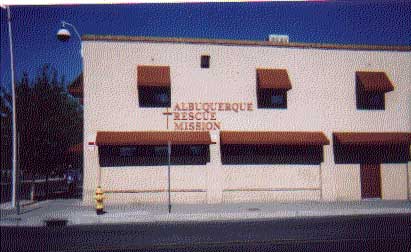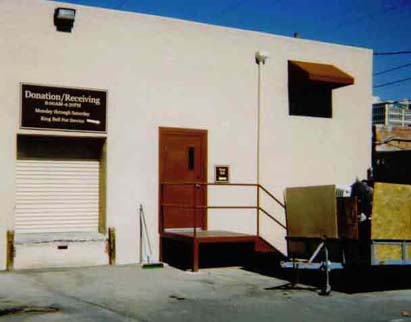Hunger Around the Nation: Focus on Albuquerque, New Mexico
First of three sections. For subsequent sections, see "next page".
(Albuquerque, Sept. 14, 2003)
H-U-N-G-E-R. Spell it out. In English, thatís:
How
Unwealthy
Negotiation
Gets
Everyone
Respect.
At least thatís how it feels to a homeless person who needs a meal.
Albuquerque Rescue Mission
Without the Albuquerque Rescue Mission (ARM), the homeless here would go hungry.
As the largest city in a rural state, Albuquerque brings people together, some with their most basic needs, those of food, clothing, and shelter.
In the 1950s, people came to Albuquerque looking for work, drawn by the many car dealerships in the Barelas neighborhood, where the rescue mission is located. Demand for jobs exceeded their supply, and a measurable population of city homeless grew. Almost a half century ago, in 1954, the Ralston Purina grain warehouse became the site for ARM. Times changed, and the car dealerships moved outward, away from the old Spanish core, but the rescue mission remained, and endures.

Photo: Paula Smith-Vanderslice
According to Dick Austin, assistant to the executive director of ARM, who has worked there since 1990, a move to a place in the country would strengthen the rehabilitation program, called New Life.

Photo: Paula Smith-Vanderslice
Dick Austin, Assistant to the Executive Director, ARM.
The New Life program is founded on the principles of Christian discipleship, involving computer training, education, employment readiness training, basic living skills, and job skills development. The program admits 25 people, and takes one to one and one-half years to complete, when it is felt people are ready to leave the program and function independently on their own.
Austin says that the presence of old connections in the form of drug dealers who come knocking on a program memberís window while theyíre trying to sleep is a deterrent from the personís successful rehabilitation. Moving to a new place in the country, surrounded by healing vistas that give perspective, with which New Mexico is blessed, and the chance for productive work without obstacles to that end would help give a greater meaning to "New Life" in action, according to Austin. He adds that ARM has not found such a place, but is looking to serve New Mexicans with that better, alternative solution.
The Latino emphasis on family is strong, and many of the 21 paid staff and 200 volunteers speak Spanish, which helps migrant Mexicans who come north in the summer to work on farms in the area.
Although the program emphasizes Christian discipleship, people of all backgrounds and faiths are welcome, including Moslems, Austin says. Does this cause a religious conflict?
The answer is no, not according to Austin, who maintains that hunger knows no religious boundaries.
Austin says that the primary mission of the program at ARM is to "restore individuals to productive, meaningful life." As a functioning shelter, the rescue mission serves food in baskets upon request from anyone who comes to the door, with each basket serving a family for five days, with more food given to a larger family. ARMís doors are always open, 24 hours a day, everyday, with 22 emergency beds available all the time, and 200 beds in winter.
As a 501(c)3 organization, ARM is non-profit. It depends entirely on private monetary donations, with 95 percent from individuals, and the remainder from churches and businesses. Driven by faith, it is truly of, by, and for the community.
Although Congresswoman Heather Wilson (R-First District, House of Representatives) assisted last Thanksgiving in serving food to homeless at the rescue missionís cafeteria, her presence only provides visibility for the mission. No Federal, state, United Way, or local government funding is received by ARM. A program can fall through if too dependent on Federal funds, Austin says.
Sanitation is an important consideration, and food servers all wear gloves, as this writer can attest from personal experience serving food at ARM as a volunteer. Sanitary procedures are one line of defense against lowered immunity in homeless persons, many of whom sleep in unsanitary conditions, and canít afford health care for when they get sick.
Donations also include clothing, received at a drop point. Like food, clothing is free, and available to anyone, with no criteria other than need, requiring people to help themselves by coming to ARM to receive.

Photo: Paula Smith-Vanderslice
The City of Albuquerque does administer two assistance programs; the emergency overflow shelter, and the rescue van. Both these programs operate during cold weather months, when it is more difficult to keep warm, and more life threatening. Last year, there were 15,000 overnight stays and 4,600 people were transported by van as a result of these programs. The rescue mission also picks up food from the Roadrunner Food Bank (RRFB) in Albuquerque. For more information on ARM, please visit their website at:
http://www.albqrescuemission.com
Paula L. Smith-Vanderslice, B.S., is copy editor of Hunger Notes.
This story is copyrighted.
